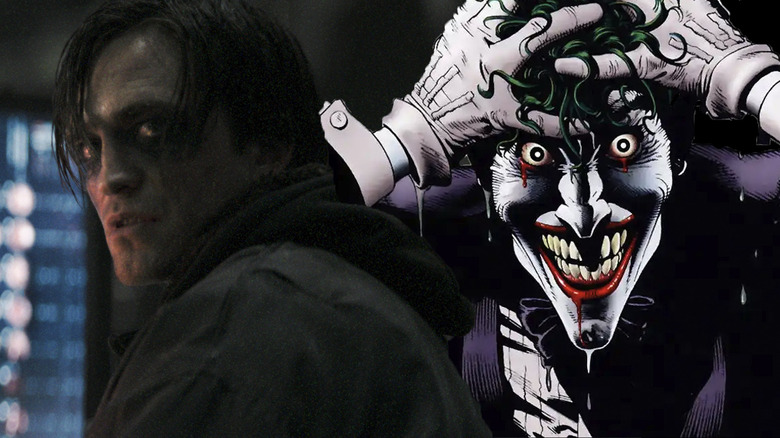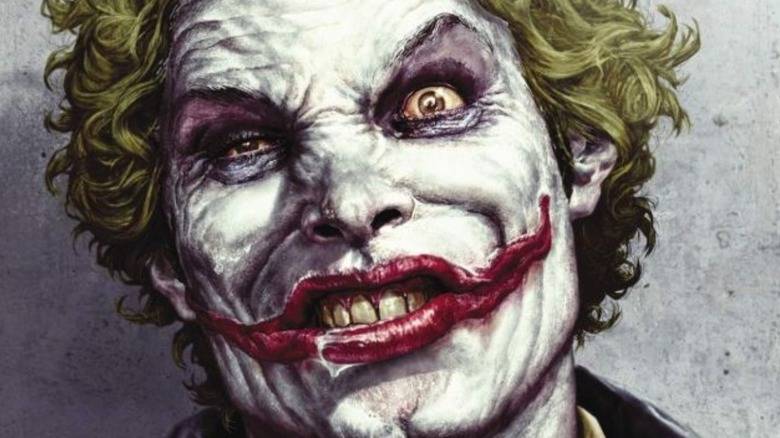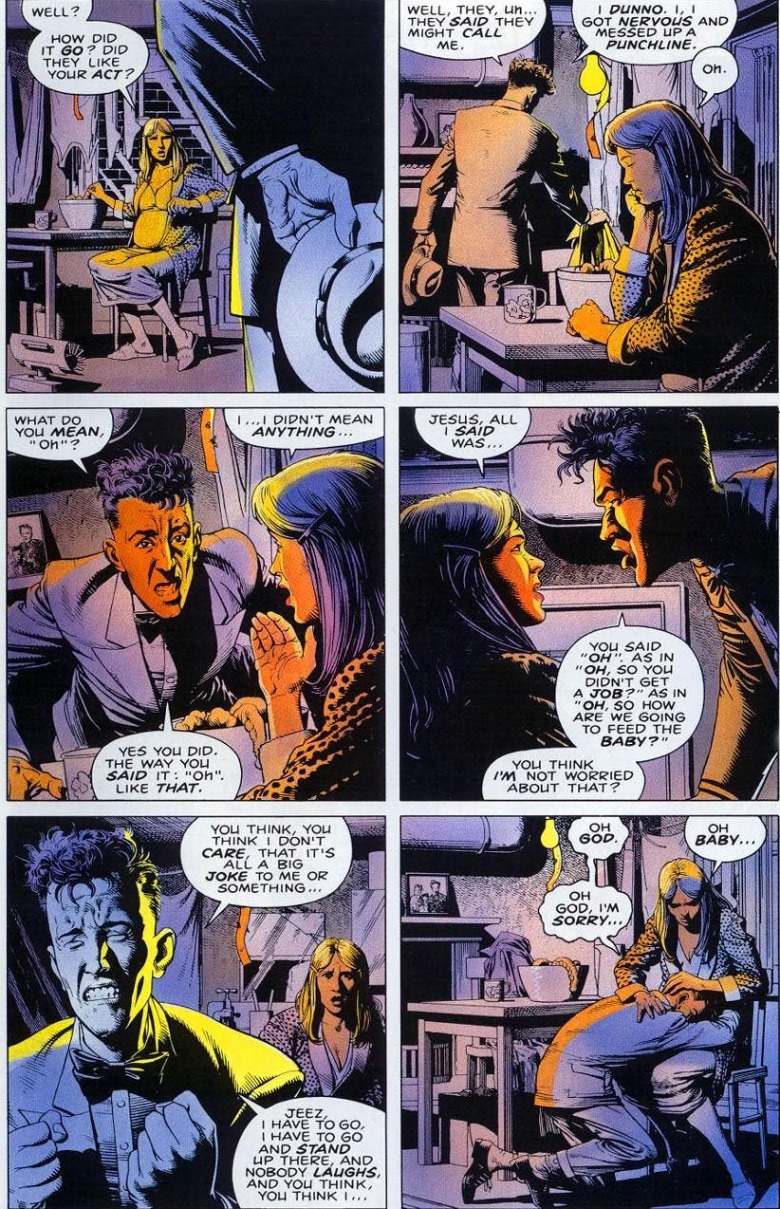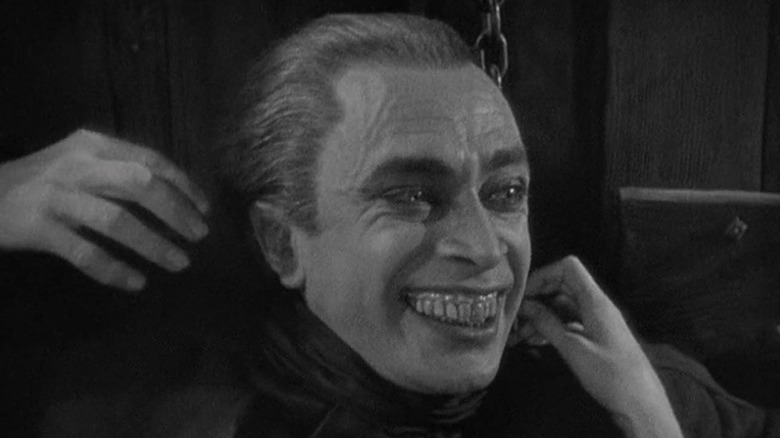The Batman Features A Killing Joke Homage That You May Not Have Noticed
This article contains spoilers for "The Batman." Proceed with caution.
In the months leading up to the release of "The Batman," we knew that the film would feature three quarters of the classic "Batman" 1966 villain line-up: Catwoman, the Riddler, and the Penguin. With director Matt Reeves' film now in theaters, it turns out the story actually has the complete set. The Joker appears in one scene, captive in Arkham Asylum and making pals with the imprisoned Riddler. But eagle-eyed fans might have also noticed a nod to the most infamous Joker story of all: Alan Moore and Brian Bolland's "The Killing Joke."
The influence of Brian Bolland and Lee Bermejo
The Joker is played by Barry Keoghan, who, in a case of misdirection, was initially said to be playing Gotham City police officer Stanley Merkel. But without the end credits, you might not have realized Keoghan was in the movie, considering his iteration of the Joker is concealed behind his cell door with only a distorted view of his face visible. Said outline does give us some hints as to what his appearance might be if the character were to return in future Bat-projects, and that outline also nods to "The Killing Joke" as a clear inspiration.
"The Killing Joke" has come under increased scrutiny in recent years for its exploitative handling of Barbara Gordon; writer Alan Moore even disowned the story, which is not surprising given his general disillusionment with superheroes. What is unimpeachable about the comic is Brian Bolland's penciling — in particular, his design for the Joker. The Clown Prince of Crime was always lankier than the muscle-bound Caped Crusader, but in that comic, Bolland drew the Joker as pencil-thin with particular emphasis on his protruding neck and pointed jaw. Artists ranging from Bob Kane to Neal Adams had drawn the Joker with his hair slicked back, but in "The Killing Joke," Bolland gave him a messier but still upright haircut, which you can spot if you look closely enough in "The Bamtan."
Matt Reeves has spoken several times about how Keoghan's version of the character is not quite the Joker yet, which is reminiscent of the early days of the character in "The Killing Joke" when he was a struggling stand-up comedian before becoming the deranged villain fans recognize.
What is different from Bolland's "The Killing Joke" design is that, in the few brief shots of the imprisoned Joker we see in "The Batman," the character's mouth is deformed, with his trademark smile stretching far back into his cheeks. This calls to mind the Joker as drawn by Lee Bermejo, artist of the "Joker" graphic novel written by Brian Azzarello. From what we can see of Keoghan's Joker, his outline very much looks like a melding of Bolland's and Bermejo's Jokers.
You wanna know how he got those scars?
The other famously scarred iteration of the Joker is Heath Ledger's in "The Dark Knight." Indeed, Ledger's Joker is very similar to (though not inspired by) Bermejo's. However, in an interview with IGN, director Matt has said his backstory for the Joker would be different from the typical chemical bath origin or the Glasgow smile in "The Dark Knight":
"[The Joker's] got this congenital disease. He can never stop smiling ... What if this is something that he's been touched by from birth and that he has a congenital disease that refuses to let him stop smiling? And he's had this very dark reaction to it, and he's had to spend a life of people looking at him in a certain way. This idea of him being very incisive and brilliant and being able to get into your mind and having this nihilistic point of view that, from his inception, from his birth, life has been a cruel joke on him, and this is his response. Eventually, he is going to declare himself as a clown, declare himself as the Joker."
In the same interview, when discussing his inspirations, Reeves name-checked Conrad Veidt in "The Man Who Laughs." In that 1928 silent film, Veidt played Gwynplaine, a deformed man whose face is contorted into a permanent, unsettling grin. The Joker's team of co-creators, Bill Finger, Bob Kane, and Jerry Robinson, used Veidt's Gwynplaine as their main inspiration when designing the villain for the comics.
Whether or not we get to see more of Keoghan's version of the character remains to be seen, but even in the purposefully obscured vision of this pre-Joker in "The Batman," the nods to silent film history and classic comics are there for those who look closely enough.



